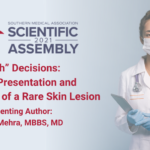Abstract | November 8, 2021
“Rash” Decisions- A Case Presentation and Management of a Rare Skin Lesion
Learning Objectives
- Diagnosing Urticarial Vasculitis: Urticarial vasculitis can last more than 24 hours after exposure to an inciting agent. It can be associated with normal or low complement levels. Normocomplementemic disease is considered mild and self limiting, hypocomplementemic UV can be more severe with a systemic inflammatory response and is associated with a positive C1q antibody. Biopsy can help in confirming the diagnosis.
- Managing Urticarial Vasculitis: Mild disease usually responds to antihistamines, non-steroidal anti-inflammatory drugs, and steroids; while severe cases may warrant immunosuppression with drugs like azathioprine, hydroxychloroquine, and dapsone. In cases that are resistant to therapy, plasmapheresis and anti-cytokine monoclonal antibodies have shown some promise.
Introduction: Urticarial vasculitis (UV) is a rare immune-complex mediated lesion that be infectious, autoimmune or drug induced, associated with low or normal complement levels. The exact prevalence is unknown, some describe the incidence to be between 2%-20%. It can present as painful purpura or urticaria lasting >24 hours among other manifestations. We aim to describe one such case below.
Case Presentation: A 43-year-old-female presented to our facility with a 2-day history of a painful pruritic rash that initially started on her back and quickly spread cephalo-caudally. She mentioned being scratched by a friend’s cat few hours prior to onset of the rash. Denied having any relief with oral antihistamines or steroids. She reported a history of type 2 diabetes and coronary artery disease status post a CABG surgery 8 years ago, and a recent drug eluding stent placement on dual antiplatelet therapy (DAPT). Medications included aspirin, clopidogrel, lisinopril, hydrochlorothiazide, rosuvastatin, glimepiride and metformin.
When examined, the patient had a diffuse urticarial rash with erythematous borders, associated angioedema of the face and lips. She was afebrile, pulse 75 beats/min, respirations 18 breaths/min, BP 106/71, saturating at 96% on ambient air. Labs, including autoimmune studies, were unremarkable with normal complement levels.
Final/Working diagnosis: She was diagnosed with drug induced normocomplementemic UV
Management & Outcome: ACE inhibitors are a rare but known cause of UV with angioedema, and lisinopril was suspected to be the causative agent with a Naranjo adverse drug reaction probability score of 5 and therefore discontinued. She was treated with topical and IV steroids, antihistamines, and mast cell stabilizers with resolution of the rash. A biopsy was not obtained as the risk of stent re-thrombosis would be high with discontinuing DAPT to obtain the biopsy. The patient was seen outpatient at regular intervals with no reported recurrence of the rash.

